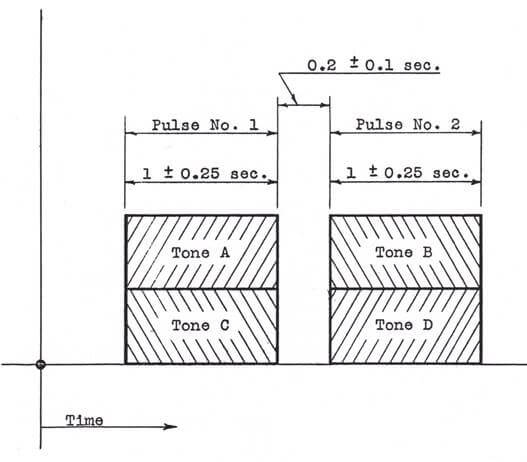How SELCAL Works
Almost every aircraft operating over the ocean or in remote areas has a SELCAL code registered with ASRI. The SELCAL code is entered into field 18 of the aircraft’s flight plan that is filed with the relevant aviation authorities. When a ground station wishes to communicate with an aircraft, the radio operator enters the required SELCAL code into the radio system which then transmits the SELCAL tones. All aircraft monitoring the assigned radio channel will receive the SELCAL broadcast, but only those that have been programmed with the specific 4-alphabetic code will be alerted. The crew will then respond to the ground station operator using ICAO recommended voice radio procedures before confirming the message and the necessary actions.
SELCAL codes are made up of the various combinations of alphabetic characters represented as two pairs (for example AC-BD), with each character representing a unique audio frequency (see table at the bottom of this page). To transmit a SELCAL code, these audio frequencies are modulated onto the selected voice channel at the ground station transmitter. This can be for either long range High Frequency (HF) communications, or more localized Very High Frequency (VHF) voice channels. SELCAL codes are transmitted as two consecutive pulses, with the first pulse consisting of the first pair of audio tones (from our example, the AC part), and the second pulse the last pair of audio tones (the BD). The pulses are approximately 1 second in duration, separated by an interval of approximately 0.2 seconds.
The below figure gives shows how the example AC-BD code would be sent.

A special decoder on the aircraft’s radio is programmed to recognize only the audio frequencies of the SELCAL code assigned to the aircraft. When the decoder receives the correct aircraft SELCAL code, the decoder sends an alert message to the crew so they can turn the radio audio volume back up to talk with the ground station radio operator.
SELCAL code assignments have a few rules that are followed to make sure the radio systems are consistent in their usage. Firstly, a character may never be repeated, i.e. a code cannot use the ‘A’ twice. Secondly, the first character of each pair must be shown with the lowest alphanumeric character first, i.e. ‘A’ must be before ‘F’ or ‘D’ must be before ‘3’ or ‘5’ must be before ‘8’.
The following table contains the original 16 SELCAL designators (A - S) and corresponding frequencies and the new additional 16 SELCAL designators (T - 9) and corresponding frequencies. The Air Navigation Service Providers (ANSPs) are currently using the original 16 SELCAL designators operationally and will have to upgrade their ground systems to support the new SELCAL designators.
| SELCAL Code Designator | Audio Frequency (HZ) |
|---|---|
| A | 312.6 |
| B | 346.7 |
| C | 384.6 |
| D | 426.6 |
| E | 473.2 |
| F | 524.8 |
| G | 582.1 |
| H | 645.7 |
| J | 716.1 |
| K | 794.3 |
| L | 881 |
| M | 977.2 |
| P | 1083.9 |
| Q | 1202.3 |
| R | 1333.5 |
| S | 1479.1 |
| SELCAL Code Designator | Audio Frequency (HZ) |
|---|---|
| T | 329.2 |
| U | 365.2 |
| V | 405 |
| W | 449.3 |
| X | 498.3 |
| Y | 552.7 |
| Z | 613.1 |
| 1 | 680 |
| 2 | 754.2 |
| 3 | 836.6 |
| 4 | 927.9 |
| 5 | 1029.2 |
| 6 | 1141.6 |
| 7 | 1266.2 |
| 8 | 1404.4 |
| 9 | 1557.8 |